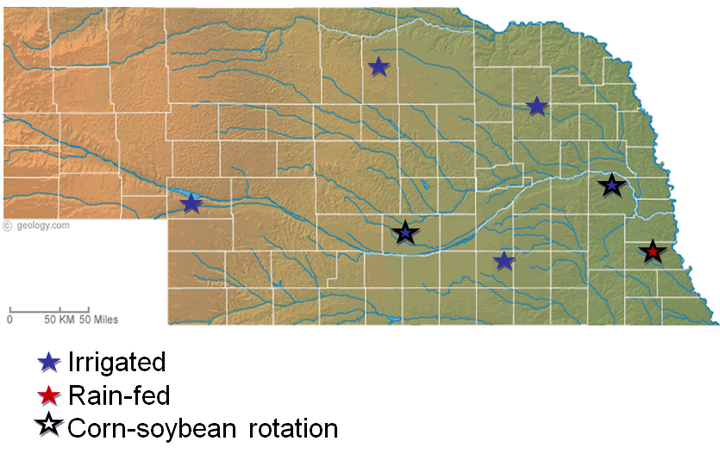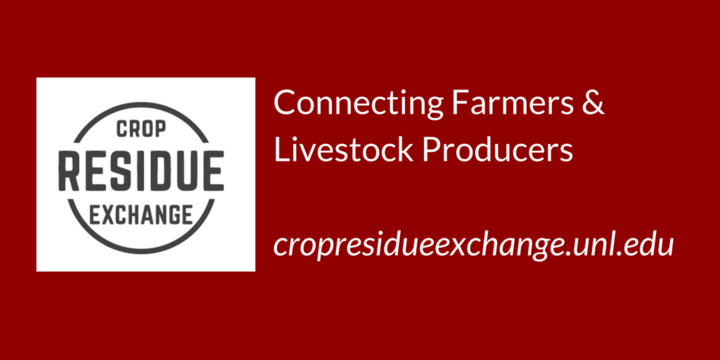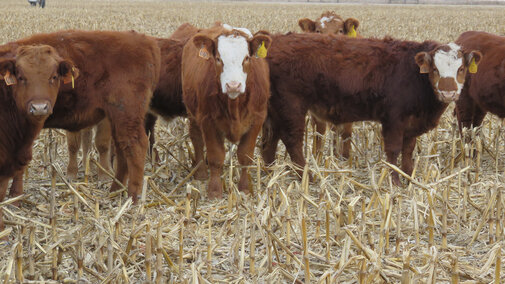Many crop farmers have concerns that cattle trampling will adversely affect soil physical properties and subsequent crop productivity. Soil compaction, measured as an increase in bulk density or penetration resistance, can affect a plant's ability to acquire water, nutrients, and oxygen. Compaction can restrict soil water movement, oxygen, and nutrient diffusion to roots, consequently reducing crop yield. Studies conducted by the University of Nebraska-Lincoln at seven locations found that grazing in late fall or winter did not result in biologically significant compaction on cropland or negative impacts on subsequent crop yields (Table 1).
Crop Yield and Compaction
Sixteen years of corn residue grazing in eastern Nebraska did not result in detrimental effects on soil properties (including bulk density and penetration resistance) or crop yields. These fields had silt-clay-loam soil, were managed under no-till, and were in a corn-soybean rotation. In fact, fall grazing (November to February) of corn residue improved soybean yields by 3.4 bu/ac. In a western Nebraska field managed in continuous corn, grazing corn residue for five years did not affect corn yields (148 versus 154 bu/ac, for not grazed and grazed, respectively).
A three-year study with five locations in eastern Nebraska also showed that grazing had no impact on subsequent crop yields. Three locations were managed under continuous corn with corn yields of 239 bu/ac for grazed and 223 bu/ac for ungrazed (which did not statistically differ). Two locations were in a corn-soybean rotation with soybean yields not differing between grazed (59 bu/ac) and ungrazed (62 bu/ac). During the last two years, soil penetration resistance was measured in the spring and was found to be slightly increased at two locations. However, the increase in penetration resistance was below the threshold for impeding root growth and did not carry over into the next year.
Surface Roughness
It should be noted that an increase in surface roughness due to grazing has been observed, especially under wet soil conditions when the soil is thawed. This can sometimes impede seed placement. A study in southeast Iowa evaluated the effects of grazing corn residue on fields managed under spring tillage or no-till in a corn-soybean rotation over a three-year period. Cows were moved to a new section of the field each month during the winter. Therefore, the impact of grazing was measured in 15 areas for each tillage treatment. There was only one instance when grazing affected soybean yield. In this instance, researchers reported a reduction in soybean yields from 45 bu/ac to 41 bu/ac when corn stover was grazed in the no-till system. Bulk density (soil porosity) was not affected. However, surface roughness was increased in this instance, suggesting seed placement may have been the cause of yield loss.
Soil Microbial Activity
After 16 years of grazing corn residue, an increase in the soil microbial community was observed (when compared to areas that were not grazed). The effects on the soil microbial community may explain the improvement in soybean yields observed in the grazed treatment because an increase in soil microbes (actinomycete bacteria and saprophytic fungi) may increase the rate of nutrient cycling.

| Factor | Effect |
|---|---|
| Soil compaction | No effect on porosity of soil; infrequent increases in penetration resistance (below levels that affect yield), and no carryover from year to year (short-lived effects no longer measurable by June). |
| Residue cover | Reduction of less than 20% |
| Soil temperature | No effect |
| Soil water content | No effect |
| Soil fertility | No effect on nutrient levels; increase in soil microbial community |
| Crop yield | No effect or slight improvement in subsequent yields |

Find residue. List Residue.
A new online tool, the Crop Residue Exchange, helps connect farmers and livestock producers who would like to graze their cattle in harvested corn fields.Soil Organic Matter and Nutrient Content
Another concern is that grazing may reduce soil organic matter (due to residue removal) or result in the export of nutrients such as N, P and K. After 16 years of grazing, no differences in soil organic matter, N, P or K were measured. It is important to remember that most of the nutrients (such as N, P, K, Ca, etc.) consumed by cattle are excreted back on to the land.
Soil Cover
Grazing only removes a small percentage of residue (target 15%) and thus cover is maintained and erosion risk is not substantially increased. However, some corn fields which, due to topography (steep slopes) and/or low corn grain yield (especially in rotation with other low residue crops like soybeans), should not be grazed by cattle because there is not enough residue present to provide adequate cover (even before grazing). Most fields in Nebraska would not fit into this category. Alternatively, grazing can be used as a residue management strategy for high yielding or continuous corn rotations where excess residue is a problem. The combination of the residue consumption and the increase in microbial activity may be beneficial in these fields.
Conclusion
Grazing corn residues can benefit both cattle and crop producers. Grazing of corn residue can be a low-cost source of winter feed for cattle and a source of income for farmers (without detrimental effects to the land).

References
Clark et al. 2003. Effects of Corn Crop Residue Grazing on Soil Physical Properties and Subsequent Soybean Production in a Corn-Soybean Crop Rotation. ISU Beef Research Report.
Drewnoski et al. 2015. Effect of Corn Residue Removal on Subsequent Crop Yields. University of Nebraska-Lincoln Beef Report p 53-55.
Rakkar et al. 2017. Effect of Long-term Corn Residue Grazing on Soil Properties. University of Nebraska-Lincoln Beef Report. p 50-52.
Ulmer et al. 2017. Effect of Corn residue Grazing or Baling on Subsequent Crop Yield and Nutrient Removal. University of Nebraska-Lincoln Beef report p 46-49.

